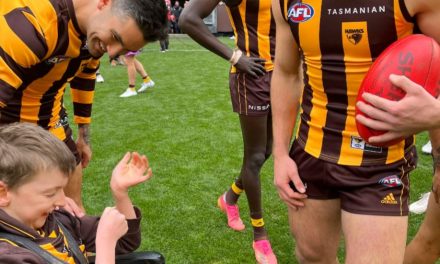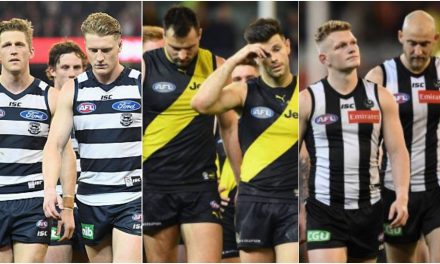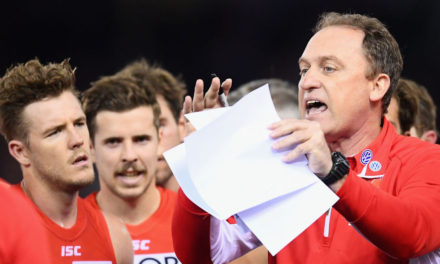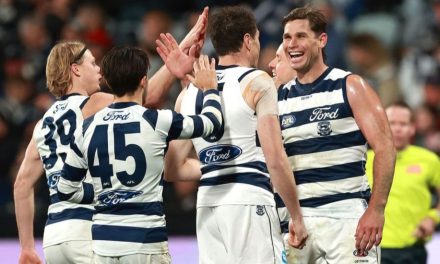Tom Hawkins (left) and Patrick Dangerfield (centre). Two pivotal parts of Geelong’s attack on the 2018 AFL season. Photo: GETTY IMAGES
Tale of the tape for your AFL team in 2018: Geelong
GEELONG
2017 record: 16 wins, 8 losses, 1 draw (3rd)
THE INS
Gary Ablett (Gold Coast), Lachlan Fogarty (Western Jets), Tim Kelly (South Fremantle), Charlie Constable (Sandringham Dragons), Gryan Miers (Geelong Falcons), Stewart Crameri (Western Bulldogs)
THE OUTS
Andrew Mackie (retired), Tom Lonergan (retired), Josh Cowan (delisted), Tom Ruggles (delisted), Steven Motlop (Port Adelaide), Darcy Lang (Carlton)
THE STRENGTHS
Superstar quality. And how. Has there been a better midfield star trio in living memory than Patrick Dangerfield, Joel Selwood and Gary Ablett? While other teams will bat deeper in 2018, none will boast three names that big. Geelong has also worked hard to achieve a nice balance of age and experience on its list after a score of veterans moving on in quick succession could have unsettled its shape for some time. There’s also a fair balance between attack and defence, the Cats finishing fourth for points scored last season and a respectable sixth for fewest points conceded. The other big plus remains Geelong’s home ground advantage, the only Victorian team with its own home ground. Since early 2007, the Cats have won 74 of 82 games at what will now be known as GMHBA Stadium, a ridiculous strike rate of more than 90 per cent. In a competition as tight as we have currently, that’s an enormous bonus.
THE WEAKNESSES
We’re yet to see the full impact of the retirements of key defensive pair Andrew Mackie and Tom Lonergan, but it’s hard to see how they aren’t going to cause major headaches not only for Geelong’s backline, but its flexibility, given how useful Harry Taylor proved regularly at the other end of the ground. Taylor will be required to play back almost exclusivity, with his only genuine key position-sized support Lachie Henderson. No doubting that pair’s quality, either, but if either goes down injured, the Cats are in real strife, the replacements potentially only Mark Blicavs or the still-to-be-tried Timm House. There was also an increasing element of “flat-track bully” about Geelong in 2017. Of the Cats’ 15 home and away wins, only four came against opposition which ended up in the top eight, four of their six defeats against the better teams.
ONE TO WATCH
Geelong hadn’t had too many Rising Star nominations in recent times until Brandan Parfitt earned one in the Cats’ round three win over Melbourne last season, a 23-disposal effort which had him among Geelong’s best handful of players. Parfitt was going great guns until he tore a hamstring in round six, missing the next eight games, and did it again soon after. But he saw out the season well, his impressive skill set, quick hands, fondness for tackling and game sense eye-catching. Most of that work was done forward of centre, but there’s an opportunity going for Parfitt to push into the midfield more in 2018, where his pace would be particularly handy. Either way, he will become an increasingly important player.
UNDER THE PUMP
It’s not all Tom Hawkins’ fault he’s in this category. He still kicked 51 goals in 2017, well over two goals per game, his fourth-best return over 11 seasons and good enough to finish eighth in the Coleman Medal. He’s still a towering presence up forward for the Cats and one who has to be watched closely whether he’s in form or not. But the game is changing. Rapidly. And if the power forwards of Hawkins’ generation are still a fair way from extinct, there’s a lot fewer of them having an impact, Richmond’s one key forward premiership set-up now perhaps more of the template. Hawkins is agile, but in the current climate, he still can’t exert enough of a presence if he’s not hauling in the marks. That has diminished his value. Geelong’s forward line hasn’t been the most cohesive unit of late. Stewart Crameri coming into the mix may change that. Perhaps it also gives Hawkins more of an opportunity to push further up the ground, where has proved of value before. But 2018 is certainly shaping as a big test for the key forward who will turn 30 midway through the season.
ROHAN CONNOLLY’S BEST 22
B: Jake Kolodjashni, Lachie Henderson, Jed Bews
HB: Tom Stewart, Harry Taylor, Zach Tuohy
C: Sam Menegola, Joel Selwood, Mitch Duncan
HF: Mark Blicavs, Stewart Crameri, Nakia Cockatoo
F: Daniel Menzel, Tom Hawkins, Brandan Parfitt
Foll: Zac Smith, Patrick Dangerfield, Gary Ablett
Inter: Scott Selwood, Cam Guthrie, Cory Gregson, Lincoln McCarthy
Emerg: Zach Guthrie, Rhys Stanley, Jordan Murdoch
Ablett may spend plenty of time forward next season, but, make no mistake, his professional pride will ensure he still delivers plenty of quality on-ball as well. This isn’t an overly quick line-up, which may see Parfitt pushing more into the midfield, while Blicavs, a man without much of a mission of late, could potentially play in a key defensive role if required.












Speaking of the forward line:
Hawkins CHF (lead up mark)
Crameri FF (Short lead)
Cockatoo, Gregson, McCarthy, Parfitt, Menzel FP
Crumbers
Dangerfield/Ablett HFF Rotating through the middle.
This is what I am hoping to see, any thoughts?
I might be in the minority, but I thought Geelong’s defence has had one too many talls for the past two years; in plenty of games they played Henderson, Lonergan and Taylor down there. The retirements might actually have made the side more balanced.
Agree with the observations about Hawkins. Chris Scott is on record as saying that injuries have forced us to play with a forward line structure that he simply didn’t want.
What I find interesting is how all the talk is of teams going with one tall and a bunch of small in the forward line, ala Richmond. But then at the same time you talk about Geelong ‘only’ having two key position sized players down back. Surely if the opposition forward lines are getting smaller, so too should the defense covering them. Teams just don’t need a lot of talls in defense anymore.
Kolodjashnij is the same height as Mackie and only 2cm smaller than Taylor. He could probably take a second tall in a pinch.
Agree Blicavs is almost a man without a position, but so too is Stanley. Perhaps both should spend some time seeing what they can do down back.
Great article, I think the addition of Stewart Crameri was a great move and will add some experience around Hawkins. Hawkins I believe needs support to either take a decent defender away, or is just in need of a genuine second option up forward to take away that obvious reliance.
Aaron Black I believe is still on the list? Do you think there will be a change in role for him? maybe try him in defence. Just seems he is sitting on the list with no mention or plans. For his sake and the teams surely there is something he can do.
I believe the three crumbing forwards returning,Gregson,McCarthy and Cockatoo will have an enormous impact on our side.Last year we lacked crumbing forwards and forward half pressure,and their absence threw our whole team balance into disarray.Hawkins had to play a lead up role with no other options available,then we had to send Taylor forward to cover Tom.When the ball hit the ground,we had nobody to crumb the packs and the ball left our forward half with ease and without any pressure what so ever.So the return of these three young players,plus the added bonus of Gary Ablett to rotate with Danger and Selwood forward,holds us in good stead next year.Our forward half is now as potent as any in the AFL.Expecting big things this year
Your 22 is pretty close. I think Tim Kelly will be in the best 22 pretty quickly. Maybe too many small forward types in there…not sure Cockatoo, Menzel, Parfitt, Gregson & McCarthy all fit in the same side. Thurlow is another I think squeezes in to help out down back. Top 2 finish but gotta get it done in September!!
Just a question: Crameri has come to the club as a Rookie which I thought meant he can’t play AFL unless promoted to the main list, and this usually happens when someone is placed on the L/T injury list. There isn’t anyone in that category so far as I know, so how will he be able to play AFL? I also doubt he’s big enough to play key forward.
The rules have been changed on this Peter. Any rookie list player who is category A (basically everyone in the rookie draft but for a few international players) is now eligible to play senior football without having to take the place of someone who goes on to the long-term injury list. PS … Crameri isn’t really key position sized, I agree, but I reckon the role of the CHF has changed quite dramatically and it’s quite common now to see smaller types playing there.